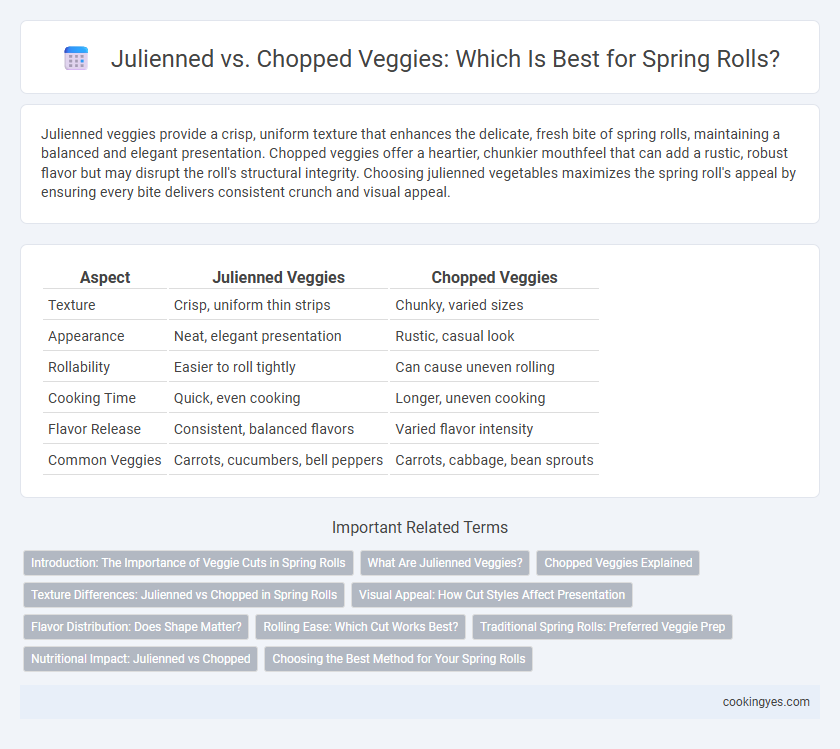Julienned veggies provide a crisp, uniform texture that enhances the delicate, fresh bite of spring rolls, maintaining a balanced and elegant presentation. Chopped veggies offer a heartier, chunkier mouthfeel that can add a rustic, robust flavor but may disrupt the roll's structural integrity. Choosing julienned vegetables maximizes the spring roll's appeal by ensuring every bite delivers consistent crunch and visual appeal.
Table of Comparison
| Aspect | Julienned Veggies | Chopped Veggies |
|---|---|---|
| Texture | Crisp, uniform thin strips | Chunky, varied sizes |
| Appearance | Neat, elegant presentation | Rustic, casual look |
| Rollability | Easier to roll tightly | Can cause uneven rolling |
| Cooking Time | Quick, even cooking | Longer, uneven cooking |
| Flavor Release | Consistent, balanced flavors | Varied flavor intensity |
| Common Veggies | Carrots, cucumbers, bell peppers | Carrots, cabbage, bean sprouts |
Introduction: The Importance of Veggie Cuts in Spring Rolls
Julienned vegetables create thin, uniform strips that enhance the texture and aesthetic appeal of spring rolls, allowing for a balanced crunch and even distribution of flavors. Chopped veggies, often larger and more irregular, can result in a bulkier filling that alters the delicate wrapper's integrity and may lead to uneven cooking. The choice between julienned and chopped vegetables significantly impacts the overall mouthfeel and presentation of spring rolls, highlighting the importance of precision in veggie cuts.
What Are Julienned Veggies?
Julienned veggies are vegetables cut into thin, matchstick-like strips, measuring approximately 1 to 2 inches long and 1/8 inch thick, which enhance the texture and presentation of spring rolls. This precise cutting technique allows for even cooking and easy rolling, ensuring each bite delivers a crisp and fresh vegetable experience. Compared to chopped veggies, julienned vegetables provide a visually appealing, uniform look and maintain a delicate balance between crunch and tenderness inside spring rolls.
Chopped Veggies Explained
Chopped veggies in spring rolls offer a chunkier texture and a more rustic bite compared to finely julienned strips, enhancing the overall mouthfeel. This preparation method allows for a variety of vegetable sizes, contributing to a heartier and more substantial filling. Chopped vegetables also release more moisture during cooking or dipping, intensifying the flavor blend inside the roll.
Texture Differences: Julienned vs Chopped in Spring Rolls
Julienned vegetables in spring rolls provide a crisp, uniform texture that enhances each bite with consistent crunch and easy folding, while chopped veggies create a varied texture that can feel chunky and less cohesive. The precise, thin strips of julienned carrots, cucumbers, and bell peppers balance moisture and crunch, preventing sogginess common with larger chopped pieces. Choosing julienned veggies optimizes mouthfeel, ensuring spring rolls maintain their delicate structure and refreshing texture.
Visual Appeal: How Cut Styles Affect Presentation
Julienned veggies create a sleek, uniform appearance in spring rolls, enhancing their visual appeal with clean, elongated strips that highlight the freshness and vibrant colors of each ingredient. Chopped veggies offer a chunkier, more rustic look, adding texture but potentially sacrificing the elegant, refined presentation desired in traditional spring rolls. The choice between julienned and chopped veggies directly influences the overall aesthetics, making julienned cuts the preferred option for a polished and visually appealing presentation.
Flavor Distribution: Does Shape Matter?
Julienned veggies in spring rolls create thin, uniform strips that enhance flavor distribution by allowing sauces and seasonings to coat each piece evenly. Chopped veggies, being bulkier and irregular, can lead to uneven flavor pockets and a less balanced taste in every bite. The shape of the veggies significantly impacts how well flavors meld and can elevate the overall freshness and texture of the spring roll.
Rolling Ease: Which Cut Works Best?
Julienned veggies create uniform, thin strips that enhance rolling ease by preventing clumps and ensuring smooth, even layers within spring rolls. Chopped veggies, being irregular and bulkier, can disrupt the roll's structure, making it more prone to tearing and uneven wrapping. For optimal rolling ease and a neatly wrapped spring roll, julienned veggies consistently outperform chopped vegetables.
Traditional Spring Rolls: Preferred Veggie Prep
Traditional spring rolls favor julienned vegetables for their uniform, thin strips that ensure even cooking and a crisp texture upon frying. Julienned carrots, cucumbers, and bell peppers maintain the delicate balance of moisture and crunch essential to authentic spring roll flavor. In contrast, chopped vegetables can create an inconsistent texture and may release excess water, compromising the crispiness of the spring roll wrapper.
Nutritional Impact: Julienned vs Chopped
Julienned vegetables in spring rolls offer increased surface area, enhancing nutrient absorption due to finer cuts that release vitamins more readily during digestion. Chopped vegetables retain their cellular structure better, preserving fiber content and providing sustained energy release. Choosing between julienned and chopped veggies can influence the spring roll's nutritional impact, balancing bioavailability with fiber retention.
Choosing the Best Method for Your Spring Rolls
Julienned veggies create thin, uniform strips that enhance the texture and visual appeal of spring rolls, allowing for even distribution and easy rolling. Chopped veggies offer a chunkier bite and can add more bulk, but may make wrapping more challenging and affect the overall crispness. Selecting julienned vegetables typically results in a more delicate, balanced spring roll ideal for a refined presentation and consistent mouthfeel.
Julienned veggies vs chopped veggies for spring rolls Infographic

 cookingyes.com
cookingyes.com